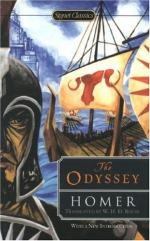{127} Sandals such as Eumaeus was making are still worn in the Abruzzi and elsewhere. An oblong piece of leather forms the sole: holes are cut at the four corners, and through these holes leathern straps are passed, which are bound round the foot and cross-gartered up the calf.
{128} See note {75}
{129} Telemachus like many another good young man seems to expect every one to fetch and carry for him.
{130} “Il.” vi. 288. The store room was fragrant because it was made of cedar wood. See “Il.” xxiv. 192.
{131} cf. “Il.” vi. 289 and 293-296. The dress was kept at the bottom of the chest as one that would only be wanted on the greatest occasions; but surely the marriage of Hermione and of Megapenthes (bk, iv. ad init.) might have induced Helen to wear it on the preceding evening, in which case it could hardly have got back. We find no hint here of Megapenthes’ recent marriage.
{132} See note {83}.
{133} cf. “Od.” xi. 196, etc.
{134} The names Syra and Ortygia, on which island a great part of the Doric Syracuse was originally built, suggest that even in Odyssean times there was a prehistoric Syracuse, the existence of which was known to the writer of the poem.
{135} Literally “where are the turnings of the sun.” Assuming, as we may safely do, that the Syra and Ortygia of the “Odyssey” refer to Syracuse, it is the fact that not far to the South of these places the land turns sharply round, so that mariners following the coast would find the sun upon the other side of their ship to that on which they’d had it hitherto.
Mr. A. S. Griffith has kindly called my attention to Herod iv. 42, where, speaking of the circumnavigation of Africa by Phoenician mariners under Necos, he writes:
“On their return they declared—I for my part do not believe them, but perhaps others may—that in sailing round Libya [i.e. Africa] they had the sun upon their right hand. In this way was the extent of Libya first discovered.
I take it that Eumaeus was made to have come from Syracuse because the writer thought she rather ought to have made something happen at Syracuse during her account of the voyages of Ulysses. She could not, however, break his long drift from Charybdis to the island of Pantellaria; she therefore resolved to make it up to Syracuse in another way.
{135} Modern excavations establish the existence of two and only two pre-Dorian communities at Syracuse; they were, so Dr. Orsi informed me, at Plemmirio and Cozzo Pantano. See The Authoress of the Odyssey, pp. 211-213.
{136} This harbour is again evidently the harbour in which Ulysses had landed, i.e. the harbour that is now the salt works of S. Cusumano.
{137} This never can have been anything but very niggardly pay for some eight or nine days’ service. I suppose the crew were to consider the pleasure of having had a trip to Pylos as a set off. There is no trace of the dinner as having been actually given, either on the following or any other morning.




